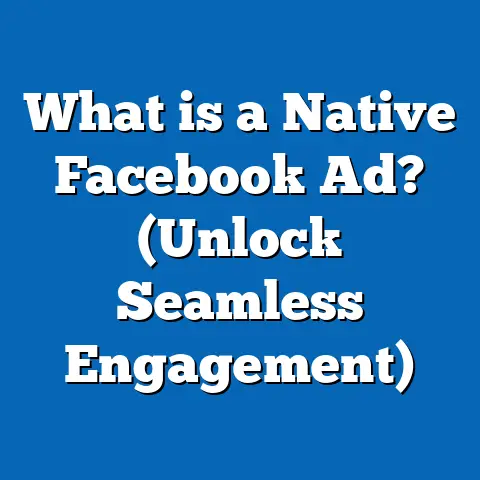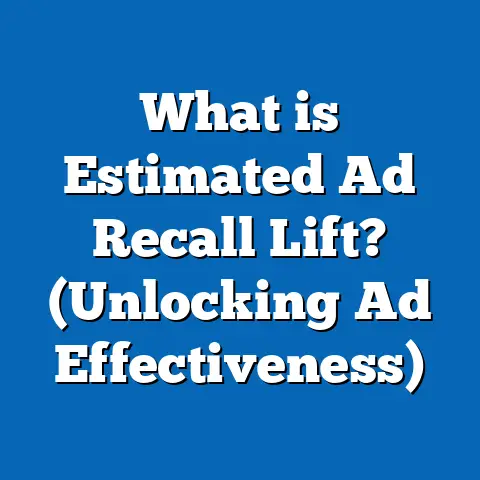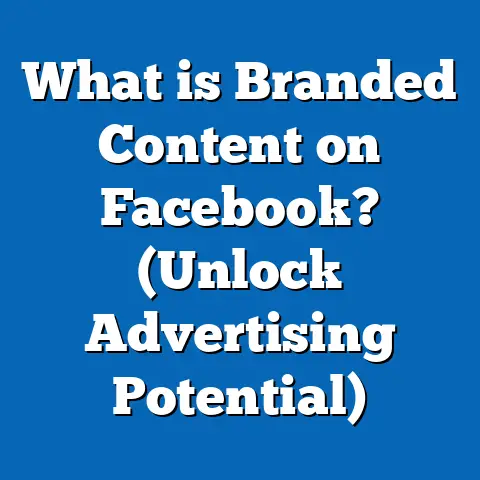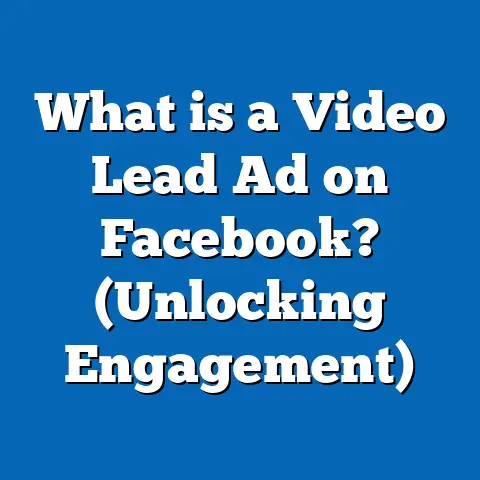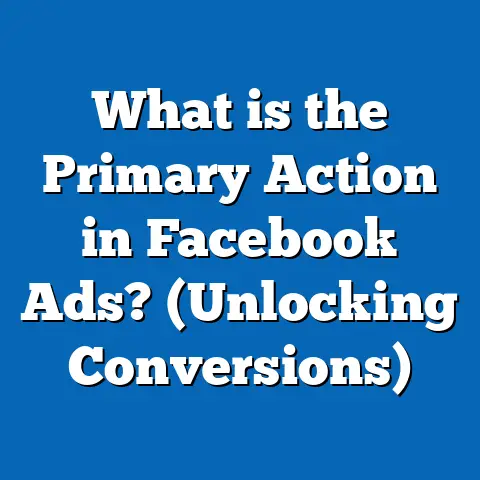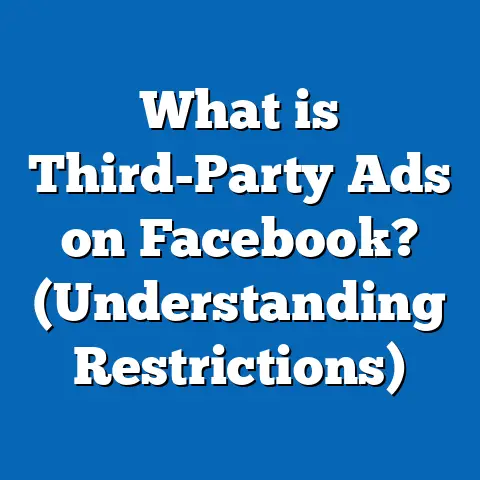What is a Facebook Ads Team? (Unlocking Success Strategies)
What is a Facebook Ads Team? (Unlocking Success Strategies)
Introduction: The Symphony of a Facebook Ads Team
Imagine an orchestra playing a complex symphony. Each musician must master their instrument and coordinate perfectly with others to produce a harmonious, captivating performance. A Facebook Ads team functions in much the same way. Just as an orchestra blends different instruments to create music, a Facebook Ads team combines various skills and roles to build, manage, and optimize high-performing advertising campaigns on Facebook.
In today’s digital marketing landscape, Facebook remains a powerhouse platform with over 2.96 billion monthly active users as of Q1 2024, making it indispensable for businesses aiming to reach targeted audiences effectively. However, navigating Facebook’s ad ecosystem requires more than just throwing money at ads—it demands strategic planning, execution, data analysis, and continuous optimization. This is where a dedicated Facebook Ads team steps in, unlocking success strategies that few solo marketers can achieve alone.
Understanding the Facebook Ads Team: Definition and Core Roles
What Exactly Is a Facebook Ads Team?
A Facebook Ads team is a group of professionals who collaborate to design, implement, monitor, and optimize advertising campaigns on Facebook and its associated platforms (Instagram, Messenger, and Audience Network). This team leverages diverse expertise—creative, technical, analytical, and strategic—to maximize return on ad spend (ROAS) and meet specific business goals.
Facebook’s ad platform offers one of the most intricate digital advertising systems globally. It allows advertisers to hyper-target users by demographics, interests, behaviors, and even device usage. Managing such complexity requires multiple skill sets working cohesively.
Core Roles in a Facebook Ads Team
The makeup of the team varies depending on company size and marketing budgets. Here are the typical roles:
Campaign Strategist / Manager
- Develops campaign objectives aligned with business goals.
- Plans targeting strategies based on audience research.
- Allocates budgets and schedules.
- Oversees the entire campaign lifecycle from launch through optimization.
- Ensures compliance with Facebook’s advertising policies.
Creative Designer
- Designs eye-catching images, videos, and GIFs suited for different ad formats.
- Understands platform specifications like aspect ratios and video lengths.
- Works closely with copywriters to ensure message-visual coherence.
Copywriter
- Crafts persuasive headlines, descriptions, and calls to action (CTAs).
- Adapts tone and style to the target audience.
- Utilizes psychology-driven tactics such as scarcity or social proof.
Data Analyst
- Tracks key performance indicators (KPIs) such as CTR, CPC, CPA, ROAS.
- Conducts A/B tests to identify winning creatives or targeting options.
- Interprets data trends to inform strategic shifts.
Audience Specialist
- Researches audience personas using Facebook Audience Insights.
- Builds custom audiences and lookalike models to refine targeting.
- Analyzes customer behavior patterns.
Technical Specialist
- Implements Facebook Pixel for conversion tracking.
- Ensures proper event setup (add-to-cart, purchases).
- Integrates ads with CRM and analytics tools.
Account Manager
- Acts as liaison between client/business stakeholders and the internal team.
- Provides regular reporting and explains campaign results.
- Coordinates approvals and feedback loops.
Why Invest in a Dedicated Facebook Ads Team?
The Complexity Behind Facebook Advertising
Facebook’s advertising system is far more nuanced than many realize. With hundreds of variables affecting performance—audience selection, bidding strategies, ad format choices—the platform requires constant attention to detail.
For example:
- Facebook offers 14 different campaign objectives ranging from awareness to conversions.
- Advertisers can select from 6 bidding strategies including lowest cost or cost cap.
- There are multiple ad placements across Facebook Feed, Stories, Messenger inbox, Instagram Feed/Stories/Reels, etc.
Each decision dramatically impacts the campaign’s effectiveness.
Data-Backed Benefits of Having a Team
Companies leveraging dedicated Facebook Ads teams consistently outperform those without specialized support:
| Metric | Improvement with Dedicated Teams | Source |
|---|---|---|
| Return on Ad Spend (ROAS) | +35% to +50% | WordStream 2023 |
| Time-to-launch Campaign | -40% | HubSpot Marketing Report 2023 |
| Click-through Rate (CTR) | +25% | Facebook IQ 2024 |
| Engagement Rate on Ads | +30% to +45% | Facebook IQ 2024 |
These numbers highlight that expertise in segmentation, creative design, copywriting, and data analysis leads to more efficient spending and better outcomes.
Risks of Not Having a Dedicated Team
Without focused resources:
- Campaigns may suffer from poor targeting causing wasted budget.
- Creative assets may lack appeal or relevance.
- Data may be misinterpreted or ignored.
- Optimization cycles slow down. Ultimately leading to low ROI or campaign failure.
Key Components of a Successful Facebook Ads Team
Strategic Planning and Goal Setting
Effective campaigns start with clear objectives. Common goals include:
- Brand awareness
- Traffic generation
- Lead generation
- Sales/conversions
- App installs Each goal requires different approaches.
Case Insight: AdEspresso found campaigns with explicitly defined goals outperform vague ones by up to 60%. This is because goal clarity informs audience selection, messaging tone, bidding strategy, and KPI tracking.
Audience Segmentation and Targeting
Facebook’s strength lies in its targeting capabilities:
- Core Audiences: Based on demographics like age, gender, location.
- Custom Audiences: Website visitors or customer lists uploaded for retargeting.
- Lookalike Audiences: Users similar to existing customers.
An adept audience specialist builds layered segments for precision targeting.
Example: A vegan skincare brand may target:
- Women aged 25–40 interested in organic products.
- Retarget past website visitors who viewed product pages but did not purchase.
- Lookalike audiences modeled on top 10% customers by purchase value.
This granular segmentation minimizes ad waste by focusing only on potential customers.
Creative Development
Ad creatives must capture attention quickly — users scroll fast through feeds. Facebook supports various formats:
| Format | Description | Best Use Case |
|---|---|---|
| Image Ads | Static photos or graphics | Simple product highlights |
| Video Ads | Short clips up to 240 mins (optimal <15 sec) | Storytelling & brand engagement |
| Carousel Ads | Multiple images/videos in one ad | Showcasing product range |
| Collection Ads | Shoppable fullscreen experience | E-commerce catalogs |
| Stories Ads | Vertical full-screen videos/images | Impulse engagement |
Videos receive 135% more organic reach than static images (Facebook IQ 2024), making them crucial for storytelling and emotional connection.
Technical Setup and Pixel Integration
Facebook Pixel is essential for:
- Tracking conversions accurately
- Optimizing campaigns based on user behavior
- Building remarketing audiences
Improper pixel setup leads to incomplete data—resulting in poor decisions. Technical specialists ensure pixel events like page views, add-to-cart actions, purchases are firing correctly.
How a Facebook Ads Team Uses Data for Continuous Optimization
Monitoring Metrics That Matter
Different campaign types prioritize different metrics:
| Campaign Type | Key Metrics |
|---|---|
| Awareness | Impressions, Reach, Frequency |
| Traffic | Click-through rate (CTR), Cost per click (CPC) |
| Conversions | Conversion rate, Cost per acquisition (CPA), ROAS |
Teams use dashboards combining Facebook Ads Manager data with third-party tools like Google Analytics or Supermetrics for comprehensive monitoring.
A/B Testing for Incremental Gains
Testing one variable at a time—be it headline or image—uncovers what resonates best. Companies employing continuous split testing improve conversion rates by about 25% year-over-year (HubSpot).
Example: Testing two versions of CTA buttons: “Shop Now” vs “Get Yours” can reveal which drives more clicks.
Budget Allocation Based on Performance
Teams use real-time data to reallocate spend dynamically:
- Scale budgets on winning ads
- Pause or adjust underperforming creatives or audiences
- Adjust bids based on cost-effectiveness
This ensures maximum efficiency without overspending on losing campaigns.
Case Study: How a Facebook Ads Team Transformed a Mid-Sized Retailer’s Sales
Client: UrbanWear — an online fashion retailer specializing in urban streetwear
Challenge: Despite increasing ad spend steadily over six months, sales plateaued and cost per acquisition was rising rapidly.
Initial Analysis:
- Targeting was broad: “Men & women ages 18–35”
- Creatives were product-centric images without lifestyle context
- No pixel event tracking beyond basic page views
- No systematic A/B testing
Team Approach:
| Step | Action Taken |
|---|---|
| Audience Research | Developed segmented personas based on shopping behavior and interests like hip-hop culture & street art |
| Creative Overhaul | Created lifestyle video ads showing products in real-life scenarios |
| Pixel Implementation | Added custom events for add-to-cart & purchase |
| A/B Testing | Tested various headlines emphasizing exclusivity vs price discounts |
| Budget Optimization | Shifted spend towards top-performing audiences & ads weekly |
Results After 6 Months:
| Metric | Before | After |
|---|---|---|
| Monthly Sales Revenue | $50K | $87.5K (+75%) |
| ROAS | 2.5x | 5x (+100%) |
| Cost per Acquisition (CPA) | $45 | $27 (-40%) |
| Ad Engagement Rate | 3% CTR avg. | 4.5% CTR avg. (+50%) |
This transformation demonstrates how skilled teamwork turns underperforming campaigns into growth engines.
Comparing Facebook Ads Teams With Other Digital Advertising Teams
Facebook Ads Teams vs Google Ads Teams
While both platforms are essential components of digital marketing strategies, they serve different purposes:
| Aspect | Facebook Ads Team | Google Ads Team |
|---|---|---|
| Targeting Methodology | Detailed demographic & interest based targeting; behavioral data | Keyword-based targeting; intent-driven search ads |
| Ad Formats | Rich visuals: videos, carousels, stories | Mostly text ads; shopping/product listing ads; some video on YouTube |
| User Intent Focus | Interruptive but highly targeted discovery & engagement | Search-driven intent; users actively looking for solutions/products |
| Data Complexity | Requires managing layered audience segments & creatives | Focuses heavily on keyword research & bidding strategies |
Many businesses combine both teams or expertise for comprehensive coverage: awareness & engagement via Facebook; high-intent conversions via Google Search.
In-House Teams vs Agencies
Companies face the decision of building their own teams or outsourcing:
| Factor | In-House Team | Agency |
|---|---|---|
| Product Knowledge | Deep understanding of company & products | Broad industry experience but less intimate brand knowledge |
| Cost Structure | Salaries + tools overhead; fixed costs even during slow periods | Typically monthly retainer or performance-based fees; variable costs |
| Flexibility & Control | Full control over campaigns; faster iterations possible | Access to wide expertise; may have limited responsiveness depending on workload |
| Scalability | Needs recruitment as needs grow; slower ramp-up time | Can quickly scale services up or down based on contracts |
Hybrid approaches where companies maintain in-house strategists but outsource creative or technical roles have become popular for balancing expertise and cost.
Advanced Strategies Employed by Expert Facebook Ads Teams
Leveraging AI and Machine Learning Tools
Facebook’s AI-driven features include:
- Automatic Placements: AI chooses where ads perform best across platforms.
- Dynamic Creative Optimization: Automatically tests combinations of images, headlines & CTAs.
- Campaign Budget Optimization: AI distributes budget across ad sets based on predicted performance.
Expert teams train these systems by providing clean data inputs and refining audience definitions regularly. A report from eMarketer shows advertisers using AI-powered optimization experience up to 30% higher conversion rates.
Custom Audiences & Retargeting Funnels
Retargeting is critical because most users don’t convert on the first interaction. Teams build layered funnels:
- Website visitors who viewed product pages but didn’t purchase → retarget with product benefits.
- Users who added items to cart but abandoned → retarget with urgency messages like limited stock.
- Past purchasers → upsell/cross-sell related products.
This granular funnel approach often doubles conversion rates compared to non-retargeted campaigns.
Integrations With CRM & Marketing Automation
Syncing Facebook campaigns with CRM systems enables:
- Automated lead follow-up emails triggered by ad conversions.
- Multi-channel attribution tracking for better ROI measurement.
- Personalized ads based on CRM customer segmentation data.
Teams use platforms like HubSpot or Salesforce integrated with Facebook Marketing API for seamless workflows.
Practical Tips for Building Your Own Effective Facebook Ads Team
- Define Clear Roles Based on Business Needs
- Start with campaign management and creative production roles.
- Add analytics and technical roles as campaigns grow in complexity.
- Invest in Training
- Facebook updates its platform frequently—regular training ensures your team is current on best practices and new features.
- Utilize resources like Facebook Blueprint courses.
- Use Collaboration Tools
- Project management software such as Asana or Trello helps keep tasks organized.
- Shared dashboards via Google Data Studio allow transparent reporting.
- Set Measurable KPIs
- Align team goals with business goals (e.g., increase leads by 20% in Q3).
- Regularly review performance together to maintain focus.
- Encourage Experimentation
- Promote a culture where testing new creatives or audiences is rewarded.
- Document learnings from each test for continual improvement.
- Maintain Strong Communication
- Frequent meetings between strategists, creatives, analysts ensure alignment.
- Use clear briefs detailing campaign goals before creative production starts.
Additional Insights: Current Industry Trends Impacting Facebook Ad Teams in 2024
Privacy Changes & Impact on Targeting
Apple’s iOS 14+ updates limited tracking capabilities through App Tracking Transparency (ATT), reducing data available for retargeting. Facebook responded by:
- Promoting aggregated event measurement.
- Encouraging use of Conversions API for direct data sharing from servers. Teams now must adapt strategies focusing more on first-party data collection and broader audience targeting while respecting privacy laws like GDPR and CCPA.
Rise of Video & Reels Content
Short-form videos via Reels have surged in popularity. Instagram Reels ads have been shown to outperform traditional feed ads in engagement metrics by up to 40% (Meta Advertising Report 2024). Teams need dedicated video production capabilities for this fast-growing format.
Increased Automation & AI Tools
More advertisers are leveraging AI-powered tools not just from Meta but third parties offering predictive analytics and creative automation. This shift requires teams to blend human creativity with machine efficiency effectively.
Summary: Unlocking Success With a Facebook Ads Team
A well-rounded Facebook Ads team acts like an orchestra delivering precise execution across multiple disciplines—from strategy through creative development to data analysis. Their combined expertise helps businesses navigate the platform’s complexity while maximizing ROI.
Key Takeaways:
- Complex platform demands require specialized roles working together.
- Clear goal-setting aligns campaigns with measurable business outcomes.
- Granular audience targeting reduces waste and improves conversion rates.
- Continuous testing and data-driven optimization fuel sustained growth.
- Integration with other marketing systems enhances automation and attribution accuracy.
Investing in building or partnering with an expert Facebook Ads team ensures your business stays competitive in today’s crowded digital marketplace.
If you want me to help build specific role descriptions or design training plans tailored for your team’s needs or industry verticals—just ask!

